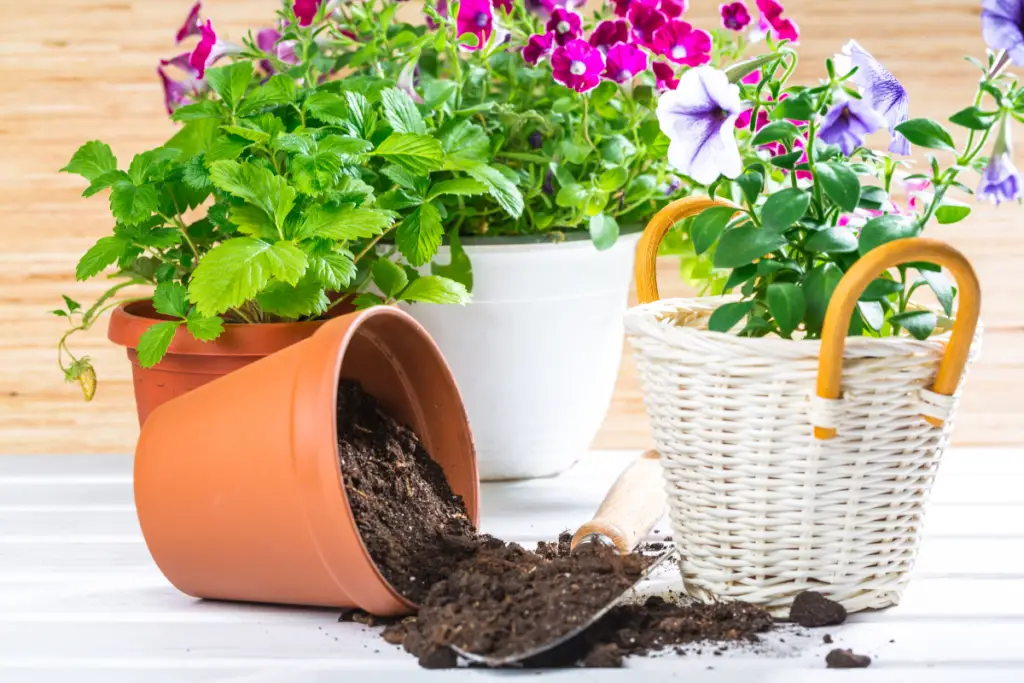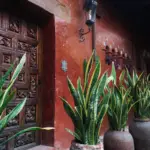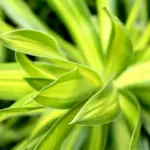Dracaena plants are popular houseplants known for their long and often variegated leaves. However, to keep them healthy and thriving, it’s essential to choose the right potting soil mix.
The best soil mix for Dracaena plants should mimic their native environment, which is the volcanic soil of Madagascar.
When it comes to soil choice, there are a few things to keep in mind. The soil mix should incorporate loam for nutrients, peat or coco coir for acidity, and vermiculite or perlite to improve drainage.
A root-bound plant may need to be repotted, and it’s crucial to choose the right pot size and soil mix to ensure proper drainage and prevent waterlogging.

Table of Contents
Understanding Dracaena Plants
Dracaena plants are tropical plants that are native to Africa and Asia. They are known for their striking foliage and are popular houseplants due to their low maintenance requirements.
Dracaena plants come in a variety of shapes, sizes, and colors, and can range from small tabletop plants to large floor plants.
One of the reasons Dracaena plants are so popular is that they are relatively easy to care for.
They can tolerate a range of lighting conditions, from low to bright indirect light, and can also handle a range of temperatures.
However, one of the most important factors in the health of a Dracaena plant is the soil mix it is planted in.
Dracaena plants require soil with excellent drainage and a fair amount of organic material. Almost any potting soil mix will work if amended, although an African violet potting mix is often the best choice for tropical plants.
It’s usually a good idea to amend your potting mix with an aggregate, such as perlite, with one part aggregate to two parts soil.
Dracaena plants prefer slightly acidic soil with a pH level between 6.0 and 6.5.
They also require a good balance of nutrients, including nitrogen, potassium, and phosphorus, to support their growth.
When choosing a potting soil mix, it’s important to look for one that has been formulated specifically for houseplants.
These mixes will have the right balance of nutrients and pH levels for your Dracaena plant.
Overall, understanding the needs of your Dracaena plant is key to keeping it healthy and thriving.
By choosing the right potting soil mix and providing the right growing conditions, you can enjoy the beauty of this tropical plant in your home for years to come.
Importance of Potting Soil
Potting soil is an essential component of any indoor plant’s growth and health. It provides the necessary nutrients and structure for plants to thrive.
Choosing the right potting soil mix for Dracaena plants is crucial for their growth and survival.
Dracaena plants are native to Madagascar and require a well-draining, nutrient-rich soil mix that mimics their natural habitat.
The right potting soil mix for Dracaena plants should be able to retain moisture, provide adequate drainage, and allow for proper aeration.
The potting soil mix should also be free of any harmful chemicals or toxins that could harm the plant.
Organic potting soil mixes are a great option for those who want to avoid synthetic fertilizers and pesticides.
Using the right potting soil mix can help prevent common issues such as root rot, nutrient deficiencies, and poor growth.
It can also help improve the overall health and appearance of the plant.
In summary, choosing the right potting soil mix for Dracaena plants is essential for their growth and health.
The potting soil mix should be well-draining, nutrient-rich, free of harmful chemicals, and able to retain moisture while allowing for proper aeration.
Best Potting Soil Mix for Dracaena Plants
Dracaena plants are easy-to-care-for houseplants that require a well-draining potting mix with high nutrient content.
The best soil mix for Dracaena plants mimics their native environment, the volcanic soil of Madagascar, and includes organic matter, drainage materials, and a slightly acidic pH.
Organic Matter
Organic matter provides nutrients for the plant and improves soil structure, allowing for better water retention.
A good potting mix for Dracaena plants should include a mix of organic matter such as loam, peat, or coco coir.
Drainage Materials
Dracaena plants require well-draining soil to prevent root rot. Incorporating materials such as vermiculite or perlite into the potting mix can improve drainage.
These materials also help to aerate the soil, allowing for better root growth.
pH Level
Dracaena plants prefer a slightly acidic soil with a pH range of 6 to 7. To achieve this, it’s recommended to mix in some peat or coco coir into the potting mix.
This will help to lower the pH level of the soil.
It’s important to note that while Dracaena plants prefer slightly acidic soil, they can tolerate a wide range of pH levels.
However, it’s best to avoid using alkaline soil as it can lead to nutrient deficiencies.
Overall, the best potting soil mix for Dracaena plants is one that includes organic matter, drainage materials, and a slightly acidic pH.
By providing a well-draining, nutrient-rich soil, you can ensure that your Dracaena plant thrives and remains healthy for years to come.
Factors to Consider When Choosing Potting Soil
When it comes to choosing the best potting soil mix for dracaena plants, there are several factors to consider.
These factors include the plant growth stage, indoor or outdoor planting, and climate and weather.
Plant Growth Stage
The growth stage of the dracaena plant is an important factor to consider when choosing potting soil.
For instance, if the plant is in its early growth stage, it requires a light potting mix that allows for easy root penetration and good drainage.
On the other hand, if the plant is mature, it needs a heavier potting mix that provides adequate support for the roots.
Indoor or Outdoor Planting
Another factor to consider when choosing potting soil is whether the dracaena plant is being grown indoors or outdoors.
Indoor plants require a potting mix that is lightweight and well-draining, while outdoor plants need a mix that can retain moisture.
Climate and Weather
The climate and weather conditions of the area where the dracaena plant is being grown also play a role in determining the best potting soil mix.
For instance, in areas with high humidity, a potting mix that is well-draining is essential to prevent root rot.
In areas with low humidity, a mix that retains moisture is necessary to keep the plant hydrated.
In conclusion, choosing the best potting soil mix for dracaena plants requires careful consideration of several factors.
By taking into account the plant growth stage, indoor or outdoor planting, and climate and weather, one can select a potting mix that will promote healthy growth and development of the plant.
Common Mistakes When Choosing Potting Soil
When it comes to choosing the right potting soil for Dracaena plants, there are some common mistakes that people make.
Here are a few things to keep in mind to ensure that you choose the best potting soil mix for your Dracaena plants:
Choosing Soil That is Too Dense
One common mistake that people make when choosing potting soil for Dracaena plants is choosing soil that is too dense.
Dense soil can lead to poor drainage, which can cause root rot and other problems. It’s important to choose a soil mix that is lightweight and well-draining.
Look for a mix that contains ingredients like perlite or vermiculite, which help to improve drainage.
Prices pulled from the Amazon Product Advertising API on:
Product prices and availability are accurate as of the date/time indicated and are subject to change. Any price and availability information displayed on [relevant Amazon Site(s), as applicable] at the time of purchase will apply to the purchase of this product.
Choosing Soil That is Too Rich
Another mistake that people make when choosing potting soil for Dracaena plants is choosing soil that is too rich.
Rich soil can lead to over-fertilization, which can cause the leaves to turn yellow and the plant to become stunted.
Look for a soil mix that is formulated specifically for Dracaena plants, or choose a mix that is low in nutrients.
Prices pulled from the Amazon Product Advertising API on:
Product prices and availability are accurate as of the date/time indicated and are subject to change. Any price and availability information displayed on [relevant Amazon Site(s), as applicable] at the time of purchase will apply to the purchase of this product.
Using Garden Soil
One of the biggest mistakes that people make when choosing potting soil for Dracaena plants is using garden soil.
Garden soil can contain weed seeds, insects, and diseases that can harm your plants. It’s also often too dense and doesn’t provide the right balance of nutrients for potted plants.
Instead, choose a soilless potting mix that is specifically formulated for potted plants.
Prices pulled from the Amazon Product Advertising API on:
Product prices and availability are accurate as of the date/time indicated and are subject to change. Any price and availability information displayed on [relevant Amazon Site(s), as applicable] at the time of purchase will apply to the purchase of this product.
Not Checking the pH
Finally, many people forget to check the pH of their potting soil before using it. Dracaena plants prefer a slightly acidic soil with a pH between 6.0 and 6.5.
If the pH of your soil is too high or too low, it can lead to nutrient deficiencies and other problems. Use a pH meter or test kit to check the pH of your potting soil before using it.
By avoiding these common mistakes, you can ensure that you choose the best potting soil mix for your Dracaena plants.
Keep in mind that different types of Dracaena plants may have slightly different soil requirements, so be sure to choose a mix that is appropriate for your specific plant.
Conclusion
In conclusion, the best potting soil mix for Dracaena plants should be loose, well-draining, and high in nutrient content.
The soil should mimic the plant’s native environment, which is the volcanic soil of Madagascar.
Incorporating loam for nutrients, peat or coco coir for acidity, and vermiculite or perlite to improve drainage can create an ideal soil mix for Dracaena plants.
Timing is also crucial when repotting Dracaena plants. The ideal time of year to repot Dracaenas is in the spring or early summer.
Repotting during this time will minimize stress on the plant and give it the best chances of success.
When watering Dracaena plants, it is essential to avoid overwatering. In the growing seasons of spring and summer, the Dracaena plant should be watered every 2-4 weeks, depending on the moisture levels of the soil.
In the slower months, the plant should be watered every 4 weeks. A pot with draining holes is ideal, but if one is not available, watering the plant a little bit less can help prevent overwatering.
It is important to note that Dracaena plants prefer a range of slightly acidic to neutral soil. Be wary of sites that describe 5.0 or 5.5 as “slightly acidic.”
These levels can harm or kill plants that require slightly acidic soil. Dracaena houseplants require the Big Three macronutrients, which are nitrogen, phosphorus, and potassium.
Overall, providing the right soil mix, watering schedule, and nutrients can help ensure that Dracaena plants thrive and remain healthy.
- How to Dry Basil Leaves: A Professional Guide
- Is an Avocado a Fruit or Vegetable? Simple Answer and Explanation
- Does Pineapple Have Seeds? Exploring the Anatomy of Pineapples
- Blooming Through Winter: Can I Grow Vegetables Indoors in the Winter?
- What Can You Grow in a Greenhouse All Year Round: A Guide to Year-Round Greenhouse Gardening
- Are Blueberries Blue? Debunking the Myth of Their Color



















